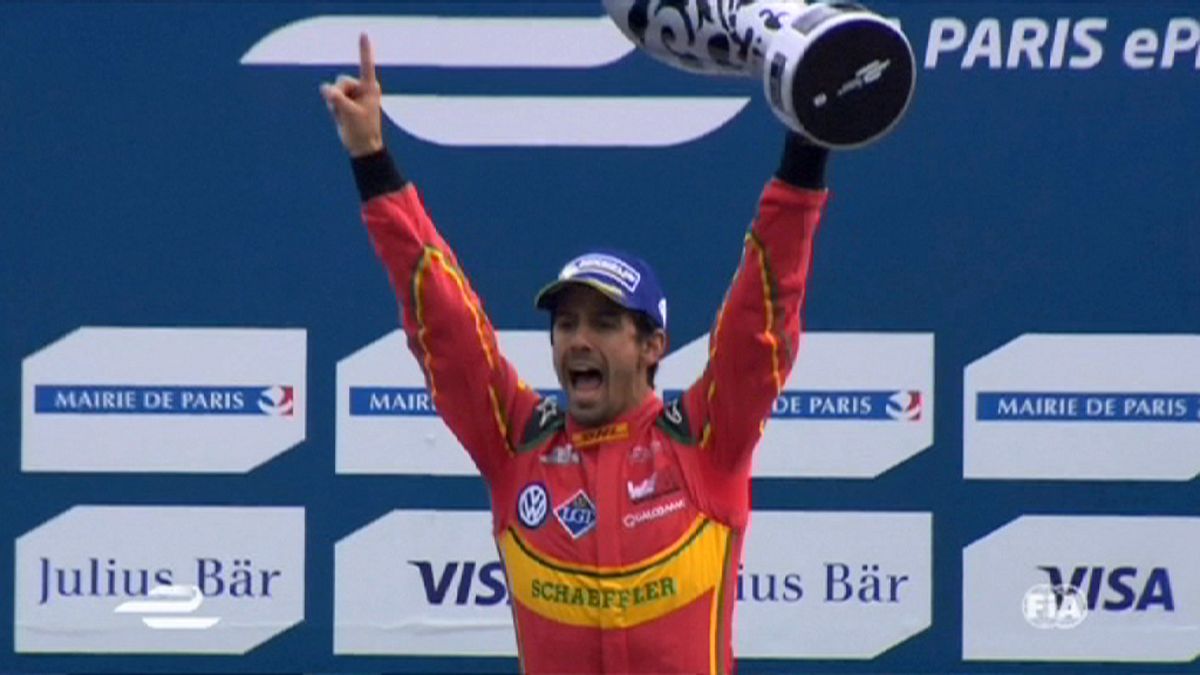Lucas di Grassi claimed his third win of the Formula E season on Sunday at the inaugural Paris ePrix. Di Grassi is taking 2016 by storm. The Audi
Lucas di Grassi claimed his third win of the Formula E season on Sunday at the inaugural Paris ePrix.
Di Grassi is taking 2016 by storm.
The Audi driver produced a dominant display in the French capital for his second consecutive victory.
He beat pole sitter Sam Bird into Turn 1 and never looked back.
Ma Qing Hua crashed heavily five laps from the end which forced the safety car to make an appearance.
The recovery of the Team Aguri vehicle, however, took too long prompting officials to end the race early with the positions of the drivers making up the final results.
With the win Brazilian Di Grassi extended his championship lead to 11 points over Swiss Sebastien Buemi, who finished third on the day, behind Frenchman Jean-Eric Vergne.
The next stop takes place in Berlin on May 21.
Behind the scenes
Euronews’Andy Robini was at the race in Paris and took the opportunity to get the lowdown on what is makes a Formula E car tick.
He spoke with Paul Faithfull, Managing Director of Potenza Technology.
Faithfull: “Electric racing car: the first point obviously is the battery…You can’t charge these cars on the sort of charger you have on a (Nissan) Leaf or something like that because these (batteries) will charge in 45 minutes so (in Formula E) you have to have a big power supply and they charge at very high voltage: 650 volts.
‘‘On these cars, the tyres are very similar to standard road tyres and the biggest difference between this and any racing formula is not just the tyre being treaded like a normal road tyre but also the size of the wheel being very similar to a road car wheel.
‘‘Usually race cars have much taller tyres, much smaller wheels. So whilst these cars are not as quick as Formula One cars, the guys who come from F1 do not say these cars are easy to drive. They came thinking they would be easy to drive and they now say ‘actually this is a real challenge’, it’s just a different challenge.”
Location, location, location
All of the drivers on the circuit have a background competing in other elite motorsport disciplines, but according to Dragon Racing driver Jérôme d’Ambrosio Formula E is an all together different beast due, in part, to the location of the races.
He said: “It’s true the cars in Formula E are not as fast. We cannot compare the technology, we’re only begining. But because our races take place in small urban circuits, two or three kilometres, on rather narrow, bumpy streets, we have strong emotions inside the car. Especially when it comes to racing, we have a lot of fun as there are plenty of opportunities to overtake.”
Vote for me
Thousands of people gather at the races can actually help decide the outcome by voting for their favourite driver using the FanBoost.
FanBoost is an online voting system where fans can chose to give their favourite driver extra power in the race.
Voting opens approximately one month before each ePrix and closes an hour before the start of the race.
The three drivers who receive the most votes are awarded an additional 30kw or roughly 40bhp that lasts for five seconds.
It can only be used once during the race, although the winner of the vote can use it in both cars – so effectively twice during the race for the most popular of drivers at the event.
Dragon Racing’s Loïc Duval said: “We must look at the future, I think it’s super interesting. The fan can help his favourite driver win a race. That was the case in Mexico, last month, where the driver who was going second took the lead thanks to the FanBoost. His fans allowed him to win the race, so I think this is really helpful. It also creates a true synergy between fans and drivers.”
A formula for the future
Formula E is now reaching the climax of its second season and so far it has been widely viewed as a success.
Taking a brand new kind of racing to city centres appears to be a masterstroke.
Not only is it a new motorsport, it has attracted a new motorsport audience – exactly what was needed.
Nelson Piquet Jr: “It’s a young sport, we’re here since a year and a half only. So we have a fan-base which is growing everyday and you can’t expect it to be huge in 2 seconds so as long as we’re growing every race and getting everybody’s attention in every city centre we come, that’s our goal. I’m sure that new, younger fans, technology fans and all kinds of people are going to love the sport more and more.”
Elsewhere
Not all the weekend’s motorsport action took place in Paris.
Back in Europe the MotoGP season hit the Jerez circuit in Spain while in the Rally world the fourth stop of the season took the elite to Argentina.
Valentino Rossi returned to the winners circle for the first time since August of last year following a dominant victory at the Spanish Grand Prix.
The Doctor steered his Yamaha to the top of the podium ahead of reigning world champion and team-mate Jorge Lorenzo and Honda’s Marc Marquez.
Heading to France for the next stop Marquez leads the title race, 17 points clear of Lorenzo and 24 points clear of Rossi.
In rally Hayden Paddon became the first driver from New Zealand to win a round on the world championship circuit after taking victory at Rally Argentina.
Paddon held off a late challenge reigning three-time world champion Sebastien Ogier to beat the Frenchman and claim a historic win.
The Hyundai driver finished 14.3 seconds clear of VW’s Ogier while Norway’s Andreas Mikkelsen steered his VW Polo to third place.
